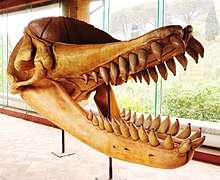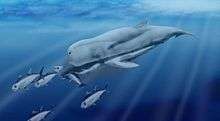Macroraptorial sperm whale
Macroraptorial sperm whales were highly predatory whales of the sperm whale family (Physeteroidea) of the Miocene epoch that hunted large marine mammals, including other whales, using their large teeth. Likewise, they were all likely the apex predator of their habitats, comparable to the modern day killer whale (Orcinus orca), and achieved great lengths, with one species–Livyatan–measuring about 13.5–17.5 metres (44–57 ft). The macroraptorial sperm whales–Albicetus, Acrophyseter, Brygmophyseter, Livyatan, Scaldicetus, and Zygophyseter[1]–are an informal grouping of genera without a family designation. All species are known by at least a skull.

Taxonomy
.jpg)
The macroraptorial sperm whales are a paraphyletic fossil group of hyper-predatory stem sperm whales comprising four genera: Acrophyseter, Brygmophyseter, Livyatan, and Zygophyseter. These macroraptorials all share large, functional, enamel-coated teeth on both the upper and lower jaws, which were used in capturing large prey. In contrast, the modern sperm whale (Physeter macrocephalus) lacks enamel, teeth in the upper jaw, and the ability to use its teeth to catch prey.[2] However, Livyatan belongs to a different lineage than the other macroraptorials, and the development of large size and the spermaceti organ, an organ that is characteristic of sperm whales, are thought to have evolved independently from the other macroraptorials. The large teeth either evolved once in the group with a basilosaurid-like common ancestor, or independently in Livyatan. The large temporal fossa depressions on the skull of raptorials is probably descended from a common ancestor (plesiomorphy). The presence of enamel is thought to be an ancient and basal characteristic, as it is present on the teeth of fetal modern sperm whales. Macroraptorials appeared during an adaptive radiation event of baleen whales in the Miocene, an increase in whale populations and diversity, implying the macroraptorials evolved specifically to exploit baleen whales.[3][4] A 30 cm (12 in) tooth found in Australia indicates macroraptorials still existed 5 mya in the Pliocene.[5]
Zygophyseter was discovered in the Pietra Leccese Formation in Italy from a skull, teeth, and vertebrae;[6] Brygmophyseter was discovered in the Bessho Formation in Japan from a nearly-complete skeleton;[7] and Acrophyseter and Livyatan both originate from the Pisco Formation in Peru and are known by only a skull.[4]

It has also been suggested that the macroraptorials be placed into the subfamily Hoplocetinae, a subfamily characterized by robust and enamel-coated teeth, alongside the genera Diaphorocetus, Idiorophus, and Hoplocetus, which are known from the Miocene to the Early Pleistocene. However, most of these whales are known from fragmentary remains or have been used as wastebasket taxa for indiscernible stem sperm whale remains.[8]
| ||||||||||||||||||||||||||||||||||||||||||||||||||||||||||||||||||||||||||||||||||||||||||||||||||||||||||||
| Raptorials in bold[3][4][2] |
Description

Macroraptorial sperm whales had large, functional, conical teeth in both jaws, as opposed to the modern sperm whale whose teeth are small and nonfunctional in the upper jaw. The teeth were deeply rooted into the gumline and could interlock, probably to aid in holding struggling prey. The teeth of Livyatan, at a length of 31 cm (12 in), were one of the biggest teeth of any animal, excluding tusks. The macroraptorials also had well-developed muscles used in biting–the temporalis and masseter. They also developed buccal exostoses in the mouth, bony growths which act as buttresses during biting, further increasing the bite force.[4][9][6][7]
Acrophyseter likely measured 3.9–4.3 m (13–14 ft) in life,[4] Brygmophyseter 7 m (23 ft),[7] Livyatan 13.5 or 17.5 m (44 or 57 ft),[3] and Zygophyseter 6.5–7 m (21–23 ft).[6] The postcranial remains of only Zygophyseter and Brygmophyseter were found. The elongated lumbar vertebrae of Zygophyseter indicate it had larger multifidus and longissimus back muscles and was, thus, faster than the modern sperm whale which,[6] comparable to other large open-ocean animals, travels horizontally at 4 km/h (2.5 mph).[10]
A characteristic of sperm whales, the macroraptorials had a curved basin–the supracranial basin–on the top of the skull. This encompassed the entire breadth if the snout in Livyatan and Brygmophyseter;[3][7] Zygophyseter and Acrophyseter, instead, had reduced basins indicating beaks.[6][4]
Paleobiology

Using their large and deeply rooted teeth, wide-opening jaws, and great size, they likely fed on a variety of sea life, including fish, cephalopods, seals, and small whales and dolphins, occupying a niche similar to the modern day killer whale (Orcinus orca).[3][4][8] In fact, Zygophyseter is known colloquially as the "killer sperm whale" in reference to this.[8] Likewise, they may have employed a similar hunting strategy of pursuing prey to tire it out before eventually drowning it. However, given their size, they probably did not need to hunt in groups. Livyatan probably targeted medium-sized whales ranging in size from 7–10 m (23–33 ft). Macroraptorials probably competed with the extinct giant shark megalodon for the same food sources.[3][11][12][13]
In sperm whales, the supracranial basin holds the spermaceti organ, a series of oil and wax reservoirs which aids in echolocation. Speculatively, the organ may also serve a secondary function, such as vocalizing, acoustic stunning of prey, head-butting between males, ramming into prey, or buoyancy control by increasing or decreasing the temperature of the wax to change the density and weight.[3]
See also
References
- Lambert, O.; Bianucci, G. (2019). "How to break a sperm whale's teeth: dental damage in a large Miocene physeteroid from the North Sea basin". Journal of Vertebrate Paleontology. 39 (4): e1660987. doi:10.1080/02724634.2019.1660987.
- Berta, A. (2017). The Rise of Marine Mammals: 50 Million Years of Evolution. Baltimore, Maryland: Johns Hopkins University Press. pp. 112–113. ISBN 978-1-4214-2326-5.
- Lambert, Olivier; Bianucci, Giovanni; Post, Klaas; de Muizon, Christian; Salas-Gismondi, Rodolfo; Urbina, Mario; Reumer, Jelle (2010). "The giant bite of a new raptorial sperm whale from the Miocene epoch of Peru" (PDF). Nature. 466 (7302): 105–108. Bibcode:2010Natur.466..105L. doi:10.1038/nature09067. PMID 20596020. Archived from the original (PDF) on 2017-12-01.
- Lambert, O.; Bianucci, G.; de Muizon, C. (2017). "Macroraptorial Sperm Whales (Cetacea, Odontoceti, Physeteroidea) from the Miocene of Peru". Zoological Journal of the Linnean Society. 179: 404–474. doi:10.1111/zoj.12456.
- "Huge Tooth Reveals Prehistoric Moby Dick in Melbourne". Australasian Science Magazine. Retrieved 20 November 2018.
- Bianucci, G.; Landini, W. (2006). "Killer Sperm Whale: a New Basal Physeteroid (Mammalia, Cetacea) from the Late Miocene of Italy". Zoological Journal of the Linnean Society. 148: 103–131. doi:10.1111/j.1096-3642.2006.00228.x.
- Hirota, K.; Barnes, L. G. (1994). "A new species of Middle Miocene sperm whale of the genus Scaldicetus (Cetacea; Physeteridae) from Shiga-mura, Japan". Island Arc. 3 (4): 453–472. doi:10.1111/j.1440-1738.1994.tb00125.x.
- Toscano, A.; Abad, M.; Ruiz, F.; Muñiz, F.; Álvarez, G.; García, E.; Caro, J. A. (2013). "Nuevos Restos de Scaldicetus (Cetacea, Odontoceti, Physeteridae) del Mioceno Superior, Sector Occidental de la Cuenca del Guadalquivir (Sur de España)" [New Remains of Scaldicetus (Cetacea, Odontoceti, Physeteridae) from the Upper Miocene, Western Sector of the Guadalquivir Basin]. Revista Mexicana de Ciencias Geológicas (in Spanish). 30 (2).
- Lambert, O.; Bianucci, G.; Beatty, B. L. (2014). "Bony Outgrowths on the Jaws of an Extinct Sperm Whale Support Macroraptorial Feeding in Several Stem Physeteroids". Naturwissenschaften. 101 (6): 517–521. Bibcode:2014NW....101..517L. doi:10.1007/s00114-014-1182-2. PMID 24821119.
- Whitehead, H. (2003). Sperm Whales: Social Evolution in the Ocean. University of Chicago Press. pp. 104–110. ISBN 978-0-226-89517-8.
- Fang, Janet (30 June 2010). "Call me Leviathan melvillei". Nature News. doi:10.1038/news.2010.322.
- Ghosh, Pallab (30 June 2010). "'Sea monster' whale fossil unearthed". BBC News. Retrieved 2 July 2010.
- "New Leviathan Whale Was Prehistoric "Jaws"?". National Geographic. 30 June 2010. Retrieved 3 July 2010.